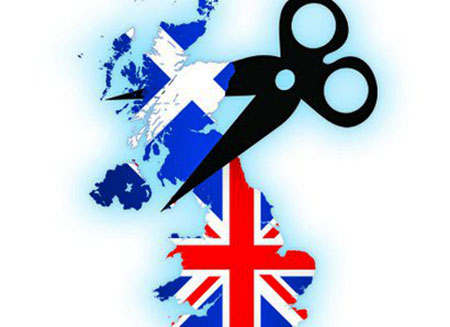|
by Ellen Brown September 17, 2014 from EllenBrown Website
Scottish voters will go to the polls on September 18th to decide whether Scotland should become an independent country.
As video blogger Ian R. Crane colorfully puts the issues and possibilities (below video):
To achieve true independence, Crane suggests the following, among other mandates:
Arguments against independence include that Scotlandís levels of public spending, which are higher than in the rest of the UK, would be difficult to sustain without raising taxes.
But that assumes the existing UK/EU investment regime.
If Scotland were to say,
A publicly-owned bank with a mandate to serve the interests of the Scottish people could help give the newly independent country true economic sovereignty.
I wrote on that possibility in December 2012, after doing a PowerPoint on it at the Royal Society of Arts in Edinburgh. That presentation was followed by one by public sector consultant Ralph Leishman, who made the proposal concrete with facts and figures.
He suggested that the Scottish Investment Bank (SIB) be licensed as a depository bank on the model of the state-owned Bank of North Dakota.
Iím reposting the bulk of that article here, in hopes of adding to the current debate.
From Revolving Fund to Credit Machine - What Scotland Could Do with Its Own Bank
The SIB is a division of Scottish Enterprise (SE), a government body that encourages economic development, enterprise, innovation and investment in business. The SIB provides public sector funding through the Scottish Loan Fund.
As noted in a September 2011 government report titled "Government Economic Strategy":
The limitation of a public loan fund is that the money can be lent only to one borrower at a time.
Invested as capital in a bank, on the other hand, public funds can be leveraged into nearly ten times that sum in loans. Liquidity to cover the loans comes from deposits, which remain in the bank, available for the use of the depositors.
As observed by Kurt Von Mettenheim, et al., in a 2008 report titled Government Banking - New Perspectives on Sustainable Development and Social Inclusion from Europe and South America (Konrad Adenauer Foundation), at page 196:
In 2012, according to Leishman, the SIB had investment funds of £23.2 million from the Scottish government.
Rounding this to £25 million, a public depository bank could have sufficient capital to back £250 million in loans. For deposits to cover the loans, the Scottish Government then had £125 million on deposit with private banks, earning very little or no interest.
Adding the revenues of just 14% of Scotlandís local governments would provide another £125 million, reaching the needed deposit total of £250 million.
The Model of the Bank of North Dakota
What the government could do with its own bank, following the model of the Bank of North Dakota (BND), was summarized by Alf Young in a follow-up article in the Scotsman.
He noted that North Dakota is currently the only U.S. state to own its own depository bank. The BND was founded in 1919 by Norwegian and other immigrants, who were determined, through their Non-Partisan League, to stop rapacious Wall Street money men foreclosing on their farms.
Young observed that all state revenues must be deposited with the BND by law. The bank pays no bonuses, fees or commissions; does no advertising; and maintains no branches beyond the main office in Bismarck.
The bank offers cheap credit lines to state and local government agencies. There are low-interest loans for designated project finance.
The BND underwrites municipal bonds, funds disaster relief and supports student loans. It partners with local commercial banks to increase lending across the state and pays competitive interest rates on state deposits.
For the past ten years, it has been paying a dividend to the state, with a quite small population of about 680,000, of some $30 million (£18.7 million) a year.
Young wrote:
Banking is not just a market good or service.
It is a vital part of societal infrastructure, which properly belongs in the public sector. By taking banking back, local governments could regain control of that very large slice (up to 40 per cent) of every public budget that currently goes to interest charged to finance investment programs through the private sector.
Recent academic studies by von Mettenheim et al. and Andrianova et al. show that countries with high degrees of government ownership of banking have grown much faster in the last decade than countries where banking is historically concentrated in the private sector.
Government banks are also LESS corrupt and, surprisingly, have been MORE profitable in recent years than private banks.
Young wrote:
The Scots are full of surprises, and independence is in their blood. Recall the heroic battles of William Wallace and Robert the Bruce memorialized by Hollywood in the Academy Award winning movie Braveheart.
Perhaps the Scots will blaze a trail for economic sovereignty in Europe, just as North Dakotans did in the U.S.
A publicly-owned bank could help Scotland take control of its own economic destiny, by avoiding unnecessary debt to a private banking system that has become a burden to the economy rather than a pillar in its support.
|

